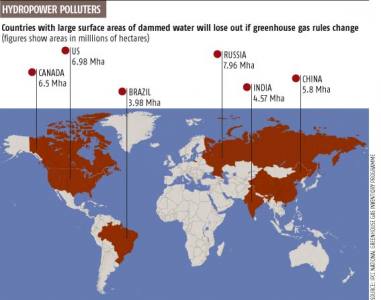Hydroelectric dams produce significant amounts of CO2 and methane – some produce more greenhouse gases than fossil fuel power plants.
Duncan Graham-Rowe, New Scientist, 26-2-2005, issue 2488
Contrary to popular belief, hydroelectric power can seriously damage the climate. Proposed changes to the way countries’ climate budgets are calculated aim to take greenhouse gas emissions from hydropower reservoirs into account, but some experts worry that they will not go far enough.
The green image of hydro power as a benign alternative to fossil fuels is false, says Éric Duchemin, a consultant for the Intergovernmental Panel on Climate Change (IPCC). “Everyone thinks hydro is very clean, but this is not the case,” he says.
Hydroelectric dams produce significant amounts of carbon dioxide and methane, and in some cases produce more of these greenhouse gases than power plants running on fossil fuels. Carbon emissions vary from dam to dam, says Philip Fearnside from Brazil’s National Institute for Research in the Amazon in Manaus. “But we do know that there are enough emissions to worry about.”
“Reservoirs convert carbon dioxide in the atmosphere into methane, which has 21 times the warming effect”
In a study to be published in Mitigation and Adaptation Strategies for Global Change, Fearnside estimates that in 1990 the greenhouse effect of emissions from the Curuá-Una dam in Pará, Brazil, was more than three-and-a-half times what would have been produced by generating the same amount of electricity from oil.
This is because large amounts of carbon tied up in trees and other plants are released when the reservoir is initially flooded and the plants rot. Then after this first pulse of decay, plant matter settling on the reservoir’s bottom decomposes without oxygen, resulting in a build-up of dissolved methane. This is released into the atmosphere when water passes through the dam’s turbines.
Seasonal changes in water depth mean there is a continuous supply of decaying material. In the dry season plants colonise the banks of the reservoir only to be engulfed when the water level rises. For shallow-shelving reservoirs these “drawdown” regions can account for several thousand square kilometres.
In effect man-made reservoirs convert carbon dioxide in the atmosphere into methane. This is significant because methane’s effect on global warming is 21 times stronger than carbon dioxide’s.
Claiming that hydro projects are net producers of greenhouse gases is not new (New Scientist, 3 June 2000, p 4) but the issue now appears to be climbing up the political agenda. In the next round of IPCC discussions in 2006 the proposed National Greenhouse Gas Inventory Programme, which calculates each country’s carbon budget, will include emissions from artificially flooded regions. But these guidelines will only take account of the first 10 years of a dam’s operation and only include surface emissions. Methane production will go unchecked because climate scientists cannot agree on how significant this is; it will also vary between dams. But if Fearnside gets his way these full emissions would be included.
With the proposed IPCC guidelines, tropical countries that rely heavily on hydroelectricity, such as Brazil, could see their national greenhouse emissions inventories increased by as much as 7 per cent (see Map). Colder countries are less affected, he says, because cold conditions will be less favourable for producing greenhouse gases.
Despite a decade of research documenting the carbon emissions from man-made reservoirs, hydroelectric power still has an undeserved reputation for mitigating global warming. “I think it is important these emissions are counted,” says Fearnside.
See also:
- The whole article ‘Role of river-suspended material in the global carbon cycle’ is here in pdf
- ‘Hydropower Disaster for Global Warming’ by Jaap Krater
- ‘Glacial Rivers Reduce Pollution on Earth’ by Gudmundur Pall Olafsson
- ‘Kárahnjúkavirkjun, sýnd veiði en ekki gefin’ eftir Grím Björnsson jarðeðlisfræðing
- Virkjanir í jökulám óhagstæðar fyrir loftslagsvernd, eftir Hjörleif Guttormsson– Enn ein falsrökin fyrir Kárahnjúkavirkjun hrakin
- ‘Stóra samhengið’ eftir Guðmund Pál Ólafsson náttúrufræðing – Virkjanaæði stjórnvalda stefnir fiskimiðum landsins í voða
